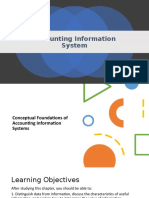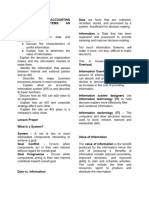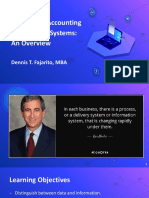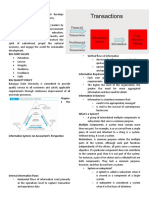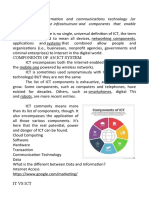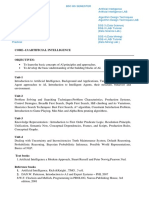14-09-20 - Introduction To Business Processes
Uploaded by
citra14-09-20 - Introduction To Business Processes
Uploaded by
citraCourse: ISYS6186-Business Process Fundamental
Effective Period : September 2020
Introduction
to Business Processes
Session 1
Acknowledgement
These slides have been adapted from:
Accounting Information Systems
14th (2018)
Marshall B. Romney, Paul John Steinbart
Pearson Education Limited, England
ISBN: 978-1-292-22008-6
Chapter 1
Learning Outcome
Student will able to :
• Describe the model of business process
Learning Objectives
After studying this chapter, student will able
to :
• Distinguish between data and information:
– Discuss the characteristics of useful
information.
– Explain how to determine the value of
information.
• Explain the decisions an organization makes:
– The information needed to make them.
– The major business processes present in most
companies.
System
A system is a set of two or more
interrelated components that
interact to achieve a goal.
system - Two or more interrelated
components that interact to
achieve a goal, often composed of http://www.naesys.com/
subsystems that support the system-integration.html#
larger system.
goal conflict - When a subsystem’s goals are inconsistent with
the goals of another subsystem or the system as a whole.
goal congruence - When a subsystem achieves its goals while
contributing to the organization’s overall goal.
Data and Information
Data
Facts that are collected,
recorded, stored, and
processed by an
information system.
Information
Data that have been
organized and processed https://www.guru99.com/difference-information-data.html
to provide meaning and
improve decision
making.
What Makes
Information Useful?
There are seven general characteristics
that make information useful:
1. Relevant: information needed to make a decision (e.g., the
decision to extend customer credit would need relevant
information on customer balance from an A/R aging report)
2. Reliable: information free from bias
3. Complete: does not omit important aspects of events or
activities
4. Timely: information needs to be provided in time to make
the decision
5. Understandable: information must be presented in a
meaningful manner
6. Verifiable: two independent people can produce the same
conclusion
7. Accessible: available when needed
What Makes
Information Useful?
To illustrate the value of information, consider the case of 7-Eleven.
When a Japanese company licensed the very successful 7-Eleven name
from Southland Corporation, it invested heavily in IT. However, the U.S.
stores did not. Each 7-Eleven store in Japan was given a computer that:
• Keeps track of the 3,000 items sold in each store and determines what
products are moving, at what time of day, and under what weather
conditions.
• Keeps track of what and when customers buy to make sure it has in
stock the products most frequently purchased.
• Orders sandwiches and rice dishes from suppliers automatically. Orders
are placed and filled three times a day so that stores always have fresh
food. In addition, suppliers can access 7-Eleven sales data electronically
so that they can forecast demand.
• Coordinates deliveries with suppliers. This reduces deliveries from 34 to
12 a day, resulting in less clerical receiving time.
• Prepares a color graphic display that indicates which store areas
contribute the most to sales and profits.
Information Needs and
Business Processes
business process - A set of related, coordinated, and
structured activities and tasks, performed by a person, a
computer, or a machine, that help accomplish a specific
organizational goal.
transaction - An agreement between two entities to exchange
goods or services, such as selling inventory in exchange for
cash; any other event that can be measured in economic terms
by an organization.
transaction processing – Process of
capturing transaction data, processing it,
storing it for later use, and producing
information output, such as a managerial
report or a financial statement.
Information Needs and
Business Processes
Information Needs and
Business Processes
revenue cycle - Activities associated with selling goods and
services in exchange for cash or a future promise to receive
cash.
expenditure cycle - Activities associated with purchasing
inventory for resale or raw materials in exchange for cash or a
future promise to pay cash.
production or conversion cycle - Activities associated with
using labor, raw materials, and equipment to produce
finished goods.
human resources/payroll cycle - Activities associated with
hiring, training, compensating, evaluating, promoting, and
terminating employees.
financing cycle - Activities associated with raising
money by selling shares in the company to
investors and borrowing money as well as paying
dividends and interest.
Interactions Between AIS and
Internal and External Parties
Basic Business Processes
Transactions between the business organization and external
parties fundamentally involve a “give–get” exchange.
a si c b u si n e ss p ro ce sses are:
These b
cl e : g iv e g oo d s / give service—get cash
– Revenue cy
cle : g et go o ds / get se rvice—give
– Expenditure cy
cash
on cy cl e : give la bor and give raw
– Prod u cti
goods
materials—get finished
get labor
– Payroll cycle: give cash—
—get cash
– Financing cycle: give cash
What Is an Accounting
Information System (AIS)?
• AIS is a system that collects, records,
stores, and processes data to produce
information for decision makers.
• Consists of
– People who use the system
– Processes (procedures and instructions)
– Technology (data, software, and information
technology)
– Controls to safeguard information
• Thus, an AIS collects and stores data,
transforms that data into information,
and provides adequate controls.
What Is an Accounting
Information System (AIS)?
FIGURE 1-3
An AIS Processes Data to Produce
Information for Decision Makers
What Is an Accounting
Information System (AIS)?
compSix
There are six components of an AIS:
1. The people who use the system o
2. The procedures and instructions used to of an nent
collect, process, and store data
AI S
3. The data about the organization and its
business activities
4. The software used to process the data
5. The information technology
infrastructure, including the computers,
peripheral devices, and network
communications devices used in the AIS
6. The internal controls and security
measures that safeguard AIS data
What Is an Accounting
Information System (AIS)?
These six components enable an AIS to
fulfill three important business functions:
1. Collect and store data about organizational
activities, resources, and personnel.
Organizations have a number of business
processes, such as making a sale or purchasing
raw materials, which are repeated frequently.
2. Transform data into information so management
can plan, execute, control, and evaluate
activities, resources, and personnel.
3. Provide adequate controls to safeguard the
organization’s assets and data.
How Does an AIS Add Value
to an Organization?
• A well thought out AIS can add value
by:
– Improving the quality and reducing
the costs of products or services
– Improving efficiency
– Sharing knowledge
– Improving efficiency and
effectiveness of its supply chain
– Improving the internal control
structure
– Improving decision making
AIS and Corporate Strategy
• An AIS is influenced by
an organization’s strategy.
• A strategy is the overall goal the
organization hopes to achieve (e.g.,
increase profitability).
• Once an overall goal is determined, an
organization can determine actions needed
to reach their goal and identify the
informational requirements (both financial
and nonfinancial) necessary to measure
how well they are doing in obtaining that
Key Terms
• System • Revenue cycle
• Goal conflict • Expenditure cycle
• Goal congruence • Production (conversion) cycle
• Data • Human resource/payroll cycle
• Information • Financing cycle
• Information technology (IT) • General ledger and reporting
• Information overload system
• Value of information • Accounting information system
• Business process (AIS)
• Transaction • Predictive analysis
• Transaction processing
• Give-get exchange
Continued to session 2
Thank you
You might also like
- Introduction To Accounting Information Systems100% (2)Introduction To Accounting Information Systems11 pages
- AIS 1 Conceptual Foundations of Accounting Information Systems (ALREADY DISCUSSED)50% (2)AIS 1 Conceptual Foundations of Accounting Information Systems (ALREADY DISCUSSED)43 pages
- BSA 2-18 - VILLAFLORES (Dr. Paz - Transcription)No ratings yetBSA 2-18 - VILLAFLORES (Dr. Paz - Transcription)25 pages
- 01 - Accounting Information Systems An OverviewNo ratings yet01 - Accounting Information Systems An Overview31 pages
- Learning Objectives: Accounting Information Systems: An OverviewNo ratings yetLearning Objectives: Accounting Information Systems: An Overview16 pages
- Accounting Information System: Chapter OneNo ratings yetAccounting Information System: Chapter One23 pages
- 01 - Introduction To Accounting Information Systems (Notes)No ratings yet01 - Introduction To Accounting Information Systems (Notes)6 pages
- Systems, Data, and Information: Questions To Be Addressed in This Chapter IncludeNo ratings yetSystems, Data, and Information: Questions To Be Addressed in This Chapter Include23 pages
- Accounting Information Systems: An OverviewNo ratings yetAccounting Information Systems: An Overview41 pages
- Module 1 - Accounting Information Systems - An OverviewNo ratings yetModule 1 - Accounting Information Systems - An Overview8 pages
- Chapter 1 - Accounting Information Systems: An Overview: Dennis T. Fajarito, MBANo ratings yetChapter 1 - Accounting Information Systems: An Overview: Dennis T. Fajarito, MBA36 pages
- Accounting Information Systems: An OverviewNo ratings yetAccounting Information Systems: An Overview37 pages
- Accounting Information Systems: An Overview: Lecture 1-Chapter 1No ratings yetAccounting Information Systems: An Overview: Lecture 1-Chapter 117 pages
- Accounting Information Systems: An OverviewNo ratings yetAccounting Information Systems: An Overview16 pages
- AIS - Chapter 2 Overview of The Business ProcessesNo ratings yetAIS - Chapter 2 Overview of The Business Processes24 pages
- CIO Best Practices: Enabling Strategic Value with Information TechnologyFrom EverandCIO Best Practices: Enabling Strategic Value with Information Technology4/5 (1)
- Business AI Data Structures and AnalyticsNo ratings yetBusiness AI Data Structures and Analytics159 pages
- Import As Import As Import As: # Importing The LibrariesNo ratings yetImport As Import As Import As: # Importing The Libraries3 pages
- Jrc120214 Ai in Medicine and Healthcare Report-Aiwatch v50No ratings yetJrc120214 Ai in Medicine and Healthcare Report-Aiwatch v5094 pages
- Daniel A. Roberts, Sho Yaida - The Principles of Deep Learning Theory - An Effective Theory Approach To Understanding Neural NetworksNo ratings yetDaniel A. Roberts, Sho Yaida - The Principles of Deep Learning Theory - An Effective Theory Approach To Understanding Neural Networks473 pages
- Machine Learning (Open Elective) B.Tech. ECE LTPC 3 0 0 3 ObjectivesNo ratings yetMachine Learning (Open Elective) B.Tech. ECE LTPC 3 0 0 3 Objectives2 pages
- Artificial Intelligence: S.Gokul, F.Ivin PrasannaNo ratings yetArtificial Intelligence: S.Gokul, F.Ivin Prasanna4 pages
- Learning Pathways by Solution - SAP University AlliancesNo ratings yetLearning Pathways by Solution - SAP University Alliances23 pages
- Syllabus Master's Programme in Computer ScienceNo ratings yetSyllabus Master's Programme in Computer Science34 pages
- Krimmel T. AI Prompt Engineering. The Engineer's Handbook 202367% (3)Krimmel T. AI Prompt Engineering. The Engineer's Handbook 2023217 pages
- Problem Statement ID – 1598 Problem Statement Title- Student Innovation Theme- Heritage and Culture PSNo ratings yetProblem Statement ID – 1598 Problem Statement Title- Student Innovation Theme- Heritage and Culture PS6 pages




